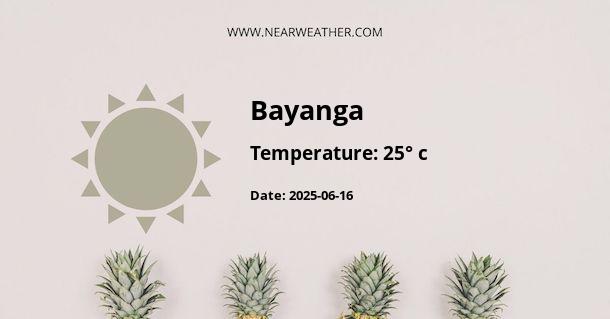Climate and Weather in Bayanga, Philippines
Bayanga, located in the Philippines, experiences a tropical climate characterized by high temperatures, abundant rainfall, and distinct wet and dry seasons throughout the year. Understanding the climate of Bayanga is essential for both residents and tourists who want to plan their activities and make the most of their time in this beautiful region. Let's take a closer look at the climate and weather patterns in Bayanga.
Temperature
Bayanga enjoys warm temperatures year-round, with little variation between seasons. The average daily temperature ranges from 25°C (77°F) to 32°C (90°F). The highest temperatures are usually experienced in April and May, while the cooler months are from December to February. Visitors to Bayanga should be prepared for the heat and ensure they stay hydrated and protect themselves from the sun.
Rainfall
Bayanga experiences a significant amount of rainfall throughout the year. The wet season typically starts in June and lasts until November, with peak rainfall occurring in August and September. During this period, the region receives heavy showers and occasional thunderstorms. The dry season runs from December to May, with February and March being the driest months. However, even during the dry season, occasional rain showers can occur.
On average, Bayanga receives around 2,000 to 2,500 millimeters (78 to 98 inches) of rainfall annually. The abundance of rainfall contributes to the lush vegetation and biodiversity found in the region, including the nearby rainforests and national parks.
Humidity
Bayanga experiences high levels of humidity throughout the year, typical of tropical climates. Humidity levels can range from 70% to 90%, making the air feel heavy and sticky. The combination of high temperatures and humidity can make the weather feel even hotter, so it's important for visitors to be prepared and dress accordingly.
Typhoons
Bayanga is located in the Philippines, which is prone to typhoons, especially during the wet season. Typhoons are tropical cyclones that can bring strong winds, heavy rainfall, and storm surges. The peak of the typhoon season in the Philippines is usually between July and October. It is recommended to monitor weather reports and take necessary precautions during this period to ensure safety.
Best Time to Visit
The best time to visit Bayanga is during the dry season, which runs from December to May. This period offers more stable weather conditions with less rainfall, allowing visitors to enjoy outdoor activities and explore the natural beauty of the region without significant interruptions. The months of February and March are particularly favorable, as they are the driest months of the year.
Climate Data Table
| Month | Average Temperature (°C) | Average Rainfall (mm) |
|---|---|---|
| January | 27 | 70 |
| February | 28 | 40 |
| March | 29 | 40 |
| April | 30 | 50 |
| May | 31 | 90 |
| June | 31 | 180 |
| July | 30 | 250 |
| August | 30 | 300 |
| September | 30 | 300 |
| October | 29 | 250 |
| November | 28 | 150 |
| December | 27 | 100 |
Weather Forecast Chart
Conclusion
Bayanga, Philippines, experiences a tropical climate with warm temperatures, abundant rainfall, and distinct wet and dry seasons. Visitors should be prepared for high humidity levels and occasional typhoons during the wet season. The best time to visit Bayanga is during the dry season, from December to May, when the weather is more stable and rainfall is lower. By understanding the climate and weather patterns in Bayanga, visitors can plan their activities and make the most of their time in this beautiful region.
A - Bayanga's Latitude is 7.521390 & Longitude is 124.252220.
A - Weather in Bayanga is 27° today.
A - Climate Conditions in Bayanga shows overcast clouds today.
A - Humidity in Bayanga is 68% today.
A - Wind speed in Bayanga is 6.91 km/h, flowing at 267° wind direction. today.
